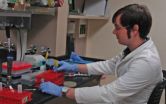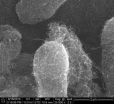(Press-News.org) Engineers at the University of Leicester have for the first time created a way of measuring how much force is used during a stabbing using a broken bottle. The advance is expected to have significant implications for legal forensics.
A team from the University has conducted a systematic study of the force applied during a stabbing and come up with the first set of penetration force data for broken glass bottles. This work has been published in the International Journal of Legal Medicine (http://www.springerlink.com/content/v21t5g05250n22xw/)
Stabbing is the most common method of committing murder in the UK. Injuries and assaults related to alcohol consumption are also a growing concern in many countries. In such cases the impulsive use of weapons such as a glass bottle is not uncommon.
In approximately 10% of all assaults resulting in treatment in the United Kingdom (UK) emergency units, glasses and bottles are used as weapons. Official UK estimates suggest that a form of glass is used as a weapon in between 3,400 and 5,400 offences per year. There is little understanding of how much force is required to create the injuries as, until now, there have been no systematic studies of how much force is required to penetrate skin with such weapons.
The study has also revealed that carrying out reconstructions of glass bottle stabbing incidents can be unreliable and may lead to a misleading approximation of force involved as glasses and bottles fracture to leave a unique stabbing surface of sharp and blunt points. This could have major implications for not only those in the field of forensics but also for anyone involved in a stabbing incident.
The study carried out by Gary Nolan, a PhD student working with the East Midlands Forensic Pathology Unit and Department of Engineering, at the University of Leicester, is the first of its kind in measuring the force required for penetration with broken glass bottles. By examining the impressions of shattered glass on a skin simulant consisting of foam with a layer of silicon rubber, researchers have managed to provide a basic classification for the presenting end of a glass bottle.
Mr Nolan said: "It is common knowledge that broken glass bottles can be used as an effective stabbing weapon and the results of the study have reaffirmed this.
"Following such incidents the forensic pathologist is often faced with the difficult task of offering an approximation of the degree of force involved. Currently there is very little work considering how much force is involved in a stabbing incident involving a broken glass bottle. This is alarming from the point of view of victims of such incidents as such information could influence the outcome of a court case.
"Our study provides the first set of penetration force data for broken glass bottles and illustrates how the consideration of proffering an opinion on force used is different to that of knives."
The study has found that the smashing of bottles to give a stabbing instrument produces a unique 'stabbing surface' for each bottle, which means it is not possible to predict a definitive value for the amount of force involved to cause a penetrating injury in a broken bottle attack.
Mr Nolan added: "Although some bottles have similar penetration forces to knives, due to the presenting broken glass geometry, most require a much larger amount of force which suggest that the majority of stabbing incidents involving bottles would require greater force than those involving knives.
"I'm very excited about this piece of work as it has great implications within the field of forensics and to society as a whole. This study provides information for forensic practitioners which could ultimately lead to a change in the way that stabbing incidents with broken glass bottles are dealt with in court."
Professor Sarah Hainsworth, Professor in Materials Engineering at the University of Leicester, said: "Gary's research has allowed us to get a better quantitative understanding of the level of force required for puncturing skin with glass. It has also allowed us to better understand how the geometry of the individual fracture surface plays a significant role in affecting that force. As far as we know, this is the first time that tests have been able to quantify the forces in this way.
"We are now working with the Materials Knowledge Transfer Network and the Institute of Materials, Minerals and Mining to take the insights from the research into standards for safer pint glasses and are looking at how we can work with the glass industry to develop new approaches to design of glasses that fracture to create less damaging surfaces."
INFORMATION:
Mr Nolan's studentship is provided by the East Midlands Forensic Pathology Unit, which is at the University of Leicester, lead by Professor Guy Rutty (gnr3@le.ac.uk).
Notes to editors:
PIX INFO: A demonstration of the stabbing demo kit is available on request via Gary Nolan on gn41@le.ac.uk or ring 0116 223 1334
Jpeg images of Gary Nolan and equipment available via pt91@le.ac.uk
For more information please contact Gary Nolan on gn41@le.ac.uk or ring 0116 223 1334.
Professor Hainsworth is also available on 0116 2525692
University of Leicester develops test for classifying force used in bottle stabbings
New study aids understanding of force required for creating injury
2011-07-22
ELSE PRESS RELEASES FROM THIS DATE:
Study suggests obesity accelerates progression of cirrhosis
2011-07-22
Researchers from the United States and Europe involved in an NIH-funded multicenter study have determined that increased body mass index (BMI) is an independent predictor of clinical decompensation in patients with compensated cirrhosis, independent of portal pressure and liver function. The findings suggest obesity accelerates cirrhosis progression and measures to reduce BMI could improve the prognosis for patients with advanced liver disease. Study details are available in the August issue of Hepatology, a journal published by Wiley-Blackwell on behalf of the American ...
Metabolic syndrome increases risk of both major types of primary liver cancer
2011-07-22
Incidence rates of hepatocellular carcinoma (HCC) and intrahepatic cholangiocarcinoma (ICC) have increased in the U.S. This population-based study publishing in the August issue of Hepatology, a journal of the American Association for the Study of Liver Diseases, found that metabolic syndrome significantly increases risk of developing these primary liver cancers.
According to data from the National Cancer Institute, 24,120 new cases of liver and intrahepatic bile duct cancer and close to 19,000 deaths from the diseases occurred in the U.S. in 2010. Major risk factors ...
Software helps synthetic biologists customize protein production
2011-07-22
A software program developed by a Penn State synthetic biologist could provide biotechnology companies with genetic plans to help them turn bacteria into molecular factories, capable of producing everything from biofuels to medicine.
"It's similar to how an engineer designs a plane or a car," said Howard M. Salis, assistant professor in agricultural and biological engineering, and chemical engineering. "When designing a biological organism, there are many combinations that the engineer must test to find the best combination. This technology allows us to quickly identify ...
Scavenger cells accomplices to viruses
2011-07-22
This release is available in German.
VIDEO:
Red-colored adenovirus particles are found in the periphery of a human epithelial cell and steadily move towards the cell nucleus at the bottom of the image. The endocytic vesicles in...
Click here for more information.
Mucosal epithelia do not have any receptors on the outer membrane for the absorption of viruses like hepatitis C, herpes, ...
Bacterial attack strategy uses special delivery of toxic proteins
2011-07-22
When competing for food and resources, bacteria employ elaborate strategies to keep rival cells at bay. Scientists have now identified a pathway that allows disease-causing bacteria to attack other bacterial cells by breaking down their cell wall.
Pseudomonas aeruginosa is a type of bacteria readily found in everyday environments. It easily forms colonies in a wide variety of settings, including medical devices, body organs and skin wounds. This allows it to cause disease and act as a major pathogen, particularly in hospitals.
Research led by Joseph Mougous, assistant ...
Blue collar workers work longer and in worse health than their white collar bosses
2011-07-22
While more Americans are working past age 65 by choice, a growing segment of the population must continue to work well into their sixties out of financial necessity. Research conducted by the Columbia University's Mailman School of Public Health and the University of Miami Miller School of Medicine looked at aging, social class and labor force participation rates to illustrate the challenges that lower income workers face in the global marketplace. The study used the burden of arthritis to examine these connections because 49 million U.S. adults have arthritis, and 21 ...
Chronic pain in homeless people not managed well: Study
2011-07-22
TORONTO, Ont., July 21, 2011—Chronic pain is not managed well in the general population and it's an even greater challenge for homeless people, according to new research by St. Michael's Hospital.
Twenty-five per cent of Canadians say they have continuous or intermittent chronic pain lasting six months or more. The number is likely to be even higher among homeless people, in part due to frequent injuries.
Of the 152 residents of homeless shelters with chronic pain studied by Dr. Stephen Hwang, more than one-third (37 per cent) had Chronic Pain Grade IV, the highest ...
Nanotechnology for water filter
2011-07-22
This release is available in German.
Nanotechnology has developed tremendously in the past decade and was able to create many new materials with a vast range of potential applications. Carbon nanotubes are an example of these new materials and consist of cylindrical molecules of carbon with diameters of a few nanometers – one nanometer is one millionth of a millimeter. Carbon nanotubes possess exceptional electronic, mechanical and chemical properties, for example they can be used to clean polluted water. Scientists of the University of Vienna had recently published ...
Fingerprinting fugitive dust
2011-07-22
This release is available in Spanish.
Each community of soil microbes has a unique fingerprint that can potentially be used to track soil back to its source, right down to whether it came from dust from a rural road or from a farm field, according to a U.S. Department of Agriculture (USDA) soil scientist.
Ann Kennedy, at the Agricultural Research Service (ARS) Land Management and Water Conservation Research Unit in Pullman, Wash., studies the biological properties of soils that affect wind erosion. She analyses the soil for the fatty acid or lipid content from the community ...
Study: Subsidizing wages at long-term care facilities would cut turnover
2011-07-22
CHAMPAIGN, Ill. — Subsidizing the wages of caregivers at group homes would likely reduce worker turnover rates and help contain costs at long-term care facilities, according to new University of Illinois research.
Elizabeth T. Powers, a professor of economics and faculty member of the Institute of Government and Public Affairs at Illinois, says that a government-sponsored wage-subsidy program could reduce the churn of low-wage caregivers through group homes by one-third.
"High rates of worker turnover have costs, and there aren't a lot incentives for the agencies that ...
LAST 30 PRESS RELEASES:
Making lighter work of calculating fluid and heat flow
Normalizing blood sugar can halve heart attack risk
Lowering blood sugar cuts heart attack risk in people with prediabetes
Study links genetic variants to risk of blinding eye disease in premature infants
Non-opioid ‘pain sponge’ therapy halts cartilage degeneration and relieves chronic pain
AI can pick up cultural values by mimicking how kids learn
China’s ecological redlines offer fast track to 30 x 30 global conservation goal
Invisible indoor threats: emerging household contaminants and their growing risks to human health
Adding antibody treatment to chemo boosts outcomes for children with rare cancer
Germline pathogenic variants among women without a history of breast cancer
Tanning beds triple melanoma risk, potentially causing broad DNA damage
Unique bond identified as key to viral infection speed
Indoor tanning makes youthful skin much older on a genetic level
Mouse model sheds new light on the causes and potential solutions to human GI problems linked to muscular dystrophy
The Journal of Nuclear Medicine ahead-of-print tip sheet: December 12, 2025
Smarter tools for peering into the microscopic world
Applications open for funding to conduct research in the Kinsey Institute archives
Global measure underestimates the severity of food insecurity
Child survivors of critical illness are missing out on timely follow up care
Risk-based vs annual breast cancer screening / the WISDOM randomized clinical trial
University of Toronto launches Electric Vehicle Innovation Ontario to accelerate advanced EV technologies and build Canada’s innovation advantage
Early relapse predicts poor outcomes in aggressive blood cancer
American College of Lifestyle Medicine applauds two CMS models aligned with lifestyle medicine practice and reimbursement
Clinical trial finds cannabis use not a barrier to quitting nicotine vaping
Supplemental nutrition assistance program policies and food insecurity
Switching immune cells to “night mode” could limit damage after a heart attack, study suggests
URI-based Global RIghts Project report spotlights continued troubling trends in worldwide inhumane treatment
Neutrophils are less aggressive at night, explaining why nighttime heart attacks cause less damage than daytime events
Menopausal hormone therapy may not pose breast cancer risk for women with BRCA mutations
Mobile health tool may improve quality of life for adolescent and young adult breast cancer survivors
[Press-News.org] University of Leicester develops test for classifying force used in bottle stabbingsNew study aids understanding of force required for creating injury



